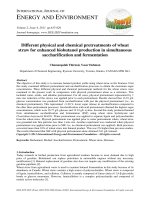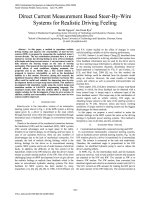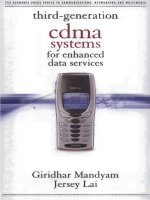mandyam, g. (2002). third-generation cdma systems for enhanced data services
Bạn đang xem bản rút gọn của tài liệu. Xem và tải ngay bản đầy đủ của tài liệu tại đây (10.19 MB, 294 trang )
-a
TIE
ACADEMIC
PRESS
SERIES
11
COYMUIICATIOIS,
IETWORKIIC
AIIO
MuiTiuBeu
4
third-generation
cdrna
systems
for
enhanced
data
services
Giridhar
Mandvam
d
Jersey
Lai
Third-Generation
CDMA
Systems
for
Enhanced Data Services
Academic
Press
Series
Communications, Networking
and
Multimedia
Editor-in-chief
Jerry
D.
Gibson
Southern Methodist University
This series has been established to bring together a variety of publications
that represent the latest in cutting-edge research, theory and applications of
all aspects of modem communication systems. All traditional and modern
aspects of communications as well as all methods
of
computer communica-
tions are to
be
included. The series will include professional handbooks,
books on communication methods and standards, and research books for
engineers and managers in the world-wide communications industry.
Books
in
Series:
Published
Handbook
of
Image and Video Processing,
AI
Bovik, editor, 2000
The E-Commerce Book,
Second Edition, Steffano Korper and Juanita Ellis,
Multimedia Communications,
Jerry Gibson, editor, 2000
Nonlinear Image Processing,
Sanjit K. Mitra and Giovanni
1.
Sicuranza,
Introduction to Multimedia Systems,
G. Bhatnagar,
S.
Mehta and Sugata
Exploratory Image Databases,
Simone Santini, 2001
2000
editors, 2000
Mitra, 2001
Forthcoming
Lossless Compression Handbook,
Khalid Sayood, August
2002
Third-Generation
CDMA
Systems
for
Enhanced Data Services
Giridhar
Mandyam
Jersey
Lai
ACADEMIC
PRESS
~~ ~
An
Elsevier
Science
Imprint
Amsterdam Boston London New York Oxford
Paris
San
Diego
San Francisco Singapore Sydney Tokyo
This book is printed on acid-free paper.
@
Academic Press is an imprint of Elsevier Science.
Copyright
0
2002, Elsevier Science (USA).
All rights reserved.
No part
of
this publication may be reproduced or transmitted in any form or
by any means, electronic or mechanical, including photocopy, recording, or
any information storage and retrieval system, without permission in writing
from the publisher.
Requests
for
permission
to
make copies
of
any
part
of
the work should be
mailed to:
Permission Department, Elsevier Science, 6277 Sea Harbor Drive, Orlando,
Florida 32887-6777.
Academic Press
An Elsevier Science Company
525
B
Street, Suite
1900,
San Diego, California 92101-4495,
USA
http://www .academicpress.com
Academic Press
84
Theobolds Road, London WClX
8RR,
UK
http://www .academicpress.com
Library
of
Congress Control Number: 2002023328
Printed in the United States of America
10987654321
Contents
Preface
1.
Introduction to Cellular Systems
2. Direct-Sequence Spread Spectrum Systems
3.
The Mobile ChaMel and Diversity Reception in
CDMA Systems
4. An Overview
of
IS-95 and cdma2000
5.1X-EV: Evolution
of
cdma2000
6.
WCDMA Overview
7. IS-95, cdma2000,1X-EV, and WCDMA Performance
8.
Handover in IS-95, cdma2000,1X-EV, and WCDMA
Appendix: CDMA Transceivers
Author Biographies
Index
vii
1
13
41
57
107
143
181
209
223
259
261
Preface
CDMA
has
been quite successful
as
a second-generation cellular system,
having achieved widespread use in particular in North America and Korea
by the turn of the twenty-first century. As the new century begins, CDMA
systems will once again find widespread
use
in the form
of
third-generation
cellular systems. However, two third-generation systems based on CDMA,
cdma2000 and WCDMA, have emerged.
As
a
result, many people both
inside and outside the wireless industry have a distinct desire
to
actually be
able to distinguish between these two systems and study the relative features
of each.
Moreover, work was initiated within the standardization bodies
responsible for cdma2000 and WCDMA (namely the 3GPP2 and 3GPP
respectively) to evolve these third-generation CDMA systems to provide
improved services for cellular packet data users. This effort has resulted in
the
1
X-EV
system
for
cdma2000 and HSDPA for WCDMA.
This book
is
intended to give the reader an overview
of
the CDMA
systems presently being deployed and used for second- and third-generation
cellular telephony. The authors hope that any reader, after reading this text,
will not only be able to determine exactly what distinguishes second-
generation CDMA systems such as
IS-95
from their third-generation
counterparts, but
also
what distinguishes cdma2000 from WCDMA.
In addition, it
is
intended that the reader come away with a better
understanding of the evolution of WCDMA and cdma2000. As packet data
services are expected
to
play a
more
prominent role in cellular telephony
during the first decade of the twenty-first century, these technologies will
become more important.
Chapter
1
of the text provides an introduction
to
cellular telephony and
the various technologies available for cellular multiple-access communica-
tions; it also provides a description
as
to what technologies are used in first-
generation, second-generation and third-generation systems. Chapter 2 pro-
vides the basic theory behind spread spectrum communications and CDMA
vii
Vlll
systems. Chapter
3
introduces concepts of the mobile wireless channel and
CDMA receiver theory for diversity reception. Chapter
4
provides an
overview
of
the second-generation
IS-95
CDMA system in the first half, and
its third-generation evolution cdma2000 in the second half. Chapter
5
discusses the 1X-EV evolution technology for cdma2000. Chapter
6
pro-
vides an overview
of
the WCDMA system. Chapter
7
provides performance
comparisons between
IS-95,
cdma2000,
1X-EV
and WCDMA. Chapter
8
discusses handover in all of these CDMA systems. Finally, Appendix A
provides a detailed analysis of CDMA transceiver design, using an
IS-95
handset as an example.
The authors would like to thank many of our Nokia colleagues for
contributing to this work. In particular, the authors would like to thank Alan
Hsu, Mark Cheng, and Craig Greer for reviewing the manuscript and
providing many insightful suggestions. In addition, the authors would like to
thank Zhigang Rong, Lin Ma, Petteri Luukkanen, and Zhoyue Pi for many
of
the results provided in Chapter
7.
The authors would
also
like to thank Tom
Derryberry and Mitch Tseng for much of their insight into the current
standardization status of CDMA systems, and to Alan Brown for his support
and encouragement in writing this book. The authors would also like to
acknowledge Joel Claypool from Academic
Press
and Prof. Jerry Gibson
from Southern Methodist University for their encouragement and advice in
preparing the text. Finally, the authors would like to thank their wives,
Chitra Mandyam and Ying-Erh
Lee,
for their support and patience.
Chapter
I
Introduction
to
Cellular
Systems
Key
Topics: Cell, mobile station,
base
station,
PSTN,
BSC, MSC,
cluster,
FDMA,
TDMA,
CDMA
Overview:
An
overview
of
cellular telephony
systems
is provided
in
this
sec-
tion.
A
brief history
of
cellular
telephony
is
provided,
and
a
basic
description
of
a
cellular system and
its
underlying components
is
given.
1.
INTRODUCTION
Cellular telephony systems
are
radio systems that involve distributed
transmission. Therefore, rather than having a single transmitter service many
different users over a wide area of coverage (e.g., commercial
FM
radio), the
coverage area is divided into smaller
areas
known
as
cells.
Each cell has one
stationary transceiver known as a
base station.
A
user
of
a cellular system communicates with the base station to place a
call. The call can be data
or
voice, and the base station routes the call to
either a terrestrial network to the termination point or to another user of the
same cellular network. Normally, for voice calls, the base station either
directly or indirectly routes the call to a
public switched telephony network
(PSTN).
Each user of a cellular system
is
also sometimes called a
subscriber.
The
basic relationship between a subscriber and the base station is shown
in
Figure
1-1.
The communications link from the base station to the subscriber
is
referred
to
as the
downlink
or
forward link,
while the link from the
subscriber to the base station is referred to
as
the
uplink
or
reverse
link.
1
2
Figure
1-1:
SubscriberfBase
Station
Link
Cellular subscribers can be stationary
or
mobile. If the subscriber is
mobile, then the cellular network must
be
able to handle the situation in
which a mobile subscriber (also known as a
mobile station)
moves from one
cell to another. This event
is
known
as
handoffor handover.
If the mobile
station can engage in simultaneous communication with multiple base
stations, then it is said to be in
soji’hadofl.
In order to ensure that a call
is
not dropped when a handoff occurs,
information about the mobile station is usually known to the base stations
involved in the handoff. Due
to
this and for other reasons, some
communication exists in the network that connects base stations together in a
cellular system. This network
is
known as the
backbone network
or
simply
the
backhaul.
The backbone network consists of several entities between the
PSTN
and
the base station. The base station usually interfaces with a
base station
controller
(BSC), which networks a cluster of base stations to ensure that
call admission and handover can function in a coordinated manner among
base stations within a geographical region. A
cluster
is
a group of cells that
use
the
complete
set
of
available
telephony channels
in
a
cellular network.
One or more BSCs are usually connected to a
mobile switching center
(MSC), which interfaces directly with the
PSTN.
The MSC contains
information about the cellular subscriber that can be used to route other
information
to
that user during the call. Moreover, a
home location register
(HLR)
may be co-located with the MSC; this entity contains user-specific
3
information
used
primarily
for authentication of
the
subscriber during call
initialization. The intercommunication between the mobile station, base
station,
BSC
and
MSC
is shown in Figure
1-2.
Figure
1-2:
Mobile
StationlBSC/MSC
Architecture
A
cellular network is comprised of many cells in a particular
geographical arrangement. Often, a base station will use a different
frequency (or frequencies) for communication than the base stations in
neighboring cells use.
This
gives rise to thefrequency reusefactor, which is
the minimum number of frequencies needed for a given cellular network to
ensure that interference within the same frequency (i.e., co-channel
interference)
is
below a tolerable level. For analysis' sake, cells
are
often
represented as hexagonal in shape to describe an ideal cellular network
(see
Figure
1-3).
This
type
of representation often results in a frequency reuse
factor of
7
(see
Figure
1-4),
as that is the minimum number of frequencies
needed
to
ensure that no neighboring base stations have to occupy the same
frequency.
4
Figure
1-3:
Hexagonal Cell
Representation
Fkuseoffl
occursonlyoutsici?of
first
ring
of
7
cells
Figure
1-4:
Frequency Reuse Factor
of
7
5
The hexagonal type of representation is adequate for preliminary analysis
of a network. In reality, several factors such
as
terrain, restrictions on base
station deployment, coverage holes, and high-density (in terms of number
of
subscribers)
areas
will most likely prevent a uniform hexagonal cell
structure.
2.
MULTIPLE-ACCESS CELLULAR
COMMUNICATIONS
Multiple-access communications
are
critical for a cellular system
to
be
commercially viable. The term
multiple access
refers to the fact that multiple
users
are
able to use a cellular system simultaneously. Multiple-access
wireless systems normally can
be
classified into three categories:
1.
Frequency division multiple access (FDMA)
2.
Time division multiple access (TDMA)
3. Code division multiple access (CDMA)
This
is
not
to
say that other types
of
multiple access systems for cellular
communications do not exist. However, these three categories encompass the
evolution
of
almost all cellular systems around the world.
2.1
Frequency Division
Multiple
Access
FDMA systems formed the basis for the first widely deployed public
cellular systems in North America. In particular, the Advanced Mobile
Phone System
(AMPS)
([1],[2]),
developed primarily by AT
&
T Inc. was
initially deployed in North America with a small rollout in Mexico City in
1981. The first United States deployment was in the Chicago area in 1983,
marking the beginning
of
a
nationwide rollout of cellular services for the
public. This system was deployed in the
800
MHz
band ("cellular band")
using
30
kHz
channel spacing that still exists in this band today.
ETACS (European Total Access Communication System) was deployed
in Europe, with the slight difference from
AMPS
in that the channel spacing
was
25
kHz.
Similarly, N-AMPS (Narrowband
AMPS)
was developed by
Motorola to work within a
10
kHz
channel spacing, thus increasing the
AMPS
capacity. These initial
FDMA
systems normally
are
referred to as
"
first-generation'' cellular systems.
6
FDMA
systems generally operate with each base station in a cluster of
cells occupying a separate frequency in
both
the transmit and receive bands
(limited frequency reuse factor), and with each frequency band servicing
only one cellular subscriber.
A
high-level example
of
the spectrum
allocation for an
FDMA
system is given in Figure
1-5.
These first-generation systems based
on
FDMA
are
primarily analog
systems, such as
AMPS.
This does not mean that it is not possible to carry
digital information on an
FDMA
carrier, however. In fact, the
AMPS
system
transmits voice in an analog format but the control information
is
transmitted
in a digital format in a
blank
and
burst
manner (meaning that the receiver
is
receiving either voice
or
control information but never both simultaneously).
Figure
1-5:
FDMA
Cellular
Communications Spectrum Allocation
FDMA
systems have inherent capacity limitations due to the fact that
each spectral channel can
be
allocated
to
only one user. Therefore, assuming
a base station has only a single transmit and single receive frequency,
it
can
only accommodate a single user. In addition, due
to
the
limitations
of
the
frequency reuse factor in a given deployment, co-channel interference is an
issue.
2.2
Time
Divison
Multiple Access
In the early 1980s. cellular operators and wireless equipment vendors
around the world recognized the capacity limitations of FDMA-based analog
cellular systems. There was a concern that with the growing popularity
of
cellular services, systems such as AMPS would not
be
able to efficiently
meet the demand. AMPS was a system conceived in the mid-l960s, and at
that time
AMPS
took advantage of the state-of-the-art technology for circuit
design. However, two decades later, real-time digital signal processing in
integrated circuits was possible. This meant that digital communications
could become a reality for cellular systems.
This
led
to
the development
of
the first digital cellular systems based on
TDMA. In North America, there was a desire to remain compatible with the
spectrum allocation already in existence in the cellular band for AMPS. As a
result, the
30-kHz
channel TDMA system known as
US
Digital Cellular
(USDC)
or
Digital AMPS (D-AMPS) was developed in the late 1980s
[l].
Also
in the 1980s, the Groupe Special Mobile (GSM) in
Europe
developed a
digital TDMA standard
to
work within
200
kHz
channels. The first GSM
deployments were in 1991, and the first D-AMPS deployments in North
America were in Canada by CANTEL in 1992. These TDMA systems
are
also grouped under a general classification for initial digital cellular
technologies known as "second generation."
TDMA cellular systems utilize spectrum in a similar fashion
to
FDMA
systems, with each base station in a cluster occupying a distinct frequency
from transmission and reception. However, each of the two spectral bands is
also allocated in time to each user in a round-robin fashion.
For
instance,
3-
slot TDMA divides transmission into three
fixed
time
periods
(slots), each of
equal duration, with a particular
slot
assigned
for transmission to
(or
from,
in
the case of the uplink) one of three possible users
(see
Figure
1-6).
This
type
of
approach requires tight synchronization between the mobile station and
base station.
8
,
User
1
User
2
Slot
User
3
Slot
User
1
Slot
rime
A simple
rule
of thumb is that the number of slots allocated in a
TDMA
system is also the number of times the capacity
is
increased when compared
to an
FDMA
system with identical bandwidth. However, this
does
not
always bear out in deployed networks, primarily due to differences in digital
processing in
TDMA
systems versus analog processing in
FDMA
systems,
including suppression of co-channel interference and mitigation of wireless
channel effects (the wireless propagation environment will be examined in
more detail in Chapter
3).
2.3
Code
Division Multiple
Access
In the mid-l980s, several researchers saw the potential for a technology
primarily used in military applications to also be used for cellular
communications. This technology, spread spectrum communications, which
involve transforming narrowband information to a wideband signal for
transmission, was seen as a mean of addressing potential capacity limitations
of
TDMA
systems (which result from the fact that the number of users on
any single frequency
is
restricted by the number of available time slots).
A spread spectrum system operates by transforming the narrowband
information
of
an individual user into wideband information by using high-
frequency codes, each unique for that particular user. By assigning different
users unique
codes,
a multiple-access system is possible,
Le.,
code
division
multiple
access
(CDMA). Moreover, in a CDMA system, frequency reuse
limitations Seen in FDMA and
TDMA
systems
are
not quite
so
critical,
as
multiple mobile stations and base stations can occupy the same frequencies
at once.
Qualcomm Incorporated
in
San Diego, California, developed
the
first
CDMA cellular system for widespread deployment in the early 1990s,
culminating with the standardization of Qualcomm's CDMA solution by the
Telecommunications Industry Association (TIA) in 1992
[3].
9
More recently, CDMA has formed the basis for enhancing cellular
systems around the world. As part of the International Telecommunications
Union's
(ITIJ)
International Mobile Telephony-2000 (IMT-2000) project,
third-generation systems were developed to improve wireless multimedia
services to cellular subscribers. Three primary technologies were approved
in 1998 by the
I?zT
as
third-generation technologies:
1.
Wideband CDMA
[4],
developed by
the
European
Telecommunication Standardization Institute
(ETSI).
2. cdma2000, developed by the TIA. cdma2000 is
backwards-compatible to IS-95.
3.
EDGE (Enhanced Data rates for GSM Evolution),
which was co-sponsored by ETSI and the TIA.
CDMA spread spectrum systems come in two types: frequency hopped
and direct sequence. CDMA using frequency hopping involves a user
transmitting over multiple frequencies consecutively in time in a
pseudorandom
manner. Pseudorandom in this case refers to the fact that the
sequence of transmission frequencies is known at the transmitter and
receiver, but appears random to any other receiver. An example of a
frequency hopping sequence is given in Figure 1-7.
Slow-hopping
systems involve a changing of frequencies at
a
slower rate
than the information bit rate, whereas
fast-hopping
requires a much faster
change of the transmission frequency than the information bit rate.
Frequency hopped systems
are
limited by the total number of hopping
frequencies available. If two users hop to the same frequency at once, they
will interfere with one another.
Direct-sequence systems work by modulating the user's information
signal with a sequence known to the receiver and transmitter.
This
sequence
is generated at a much higher rate than the user signal, literally "spreading"
the user's signal bandwidth. This process is illustrated in Figure 1-8. All
commercial cellular CDMA systems use direct-sequence spreading
as
opposed
to
frequency hopping.
In the next chapter, more detail will be provided on the technical
aspects
of direct-sequence spread spectrum systems.
10
fl
f2
f5
Time
b
Figure
1-7:
Frequency Hopping Sequence
Figure
1-8:
Direct-Sequence Spreading of Information
11
3.
CONCLUSIONS
In this chapter, the cellular concept, which makes wireless multiple-
access communications possible, was introduced.
A
brief overview of
the
different types
of
multi-access technologies available
for
wireless cellular
systems was also provided. With this background, the reader is now
prepared
to
understand the underlying direct-sequence spread spectrum
technology that makes
CDMA
possible.
REFERENCES
[I]
Rappaport, Theodore
S.
Wireless
Communications.
Upper
Saddle River,
NJ:
Prentice-Hall hc., 1996.
[2]
Fischer, R.E. "A
Subscriber
Set
for
the Equipment Test."
The
Bell
Sysrem
Technical
Journal.
Vol. 58.
No.
I.
January
1979.
pp.
123-143.
[3]
Gag. Vijay
K
IS-95
CDMA
and
cdma2000.
Upper
Saddle River,
NJ:
Prentice-
Hall
Inc.,
2000.
[4]
Holrna,
Harri,
w.d Antti Toskala, editors.
WCDMA
for
UMTS:
Radio
Accessfor
Third
Generarion
Mobile
Communicafions. West
Sussex,
United Kingdom:
John
Wiley
&
Sons,
2000.
Chapter
2
Direct-Sequence Spread Spectrum Systems
Key
Topics: Spread spectrum, direct-sequence spread spectrum,
PN
sequence
Overview:
This
chapter
will
focus
on
fundamental principles
covering
the
design
of direct-sequence spread
spectrum
systems. The basic concepts
covered here will
be
used
in
later chapters when describing existing
CDMA
wireless standards.
1.
INTRODUCTION
Direct-sequence spread spectrum (DSSS) systems form the basis for the
most widely used
CDMA
standards for public wireless systems today. These
types of systems have their genesis in the significant amount of work
performed in the area of secure communications during the early and middle
parts of the 20th century; a detailed history may be found in
[l]
and [2].
In the 193Os, wideband frequency modulation was proposed as a means
of wireless transmission of information without the information distortion
associated with narrowband
FM
systems. In 1933, Edwin Armstrong
proposed a system wherein the transmission bandwidth was spread beyond
the information bandwidth in an
FM
system. He
also
proposed the use of an
amplitude limiter at the receiver
to
eliminate the
effects
of
amplitude
variation that result from bandwidth spreading and mobile channel
distortion. He collaborated with the Radio Corporation of America to verify
his idea. This idea was followed by Gustav Guanella's invention in 1938 of
continuous-wave radar, which described a transmission method over several
13
14
different frequencies of smaller power compared to the total signal power.
This work was performed for Brown, Boveri and Co. in Switzerland.
With the advent
of
World
War
11,
the need for secure communication
brought about an even greater examination
of
the benefits of wideband
transmission. In particular, a definitive need existed for transmission
methods that were inherently resistant to narrowband interference most
likely caused by hostile parties. In addition to this "anti-jamming'' capability,
there was also a need to develop communications systems that were difficult
to intercept. In response to this need, what was probably the first public
disclosure of a spread spectrum communication system came about in
1941
with a patent by Hedy Keisler Markey (a.k.a. "Hedy
Lamarr"
of
film) and
George Anthiel. This patent described a frequency hopped guidance system
for torpedoes.
The motivation for spread spectrum systems as
a
means of multiple-
access communications is found in Claude
E.
Shannon's pioneering work in
information theory. In particular, in
1948,
Shannon derived the maximum
channel capacity of a bandlimited communications system as
In (2-1),
C
is the channel capacity (bidsecond),
B
is
the transmission
bandwidth (in
Hz),
S
is the received signal power (in watts), and
N
is
the
total noise power at the receiver. This contribution is important in that it
provides a rigorous justification for increasing the transmission bandwidth in
a communications system, as the capacity is directly related to the
transmission bandwidth
for
a given signal-to-noise ratio.
This
idea gave
impetus to the
use
of spread spectrum as a means of increasing the available
capacity for wireless systems.
Spread spectrum remained a primarily military technology until the
1970s.
In the late
1970s,
Prof. George Cooper at Purdue University
postulated that spread
spectrum
CDMA systems would
be
able
to
provide
greater capacity than the
AMPS
systems that were under development at the
time
[3
1-[4].
Shortly afterward, the Equitorial Communications Company
developed a spread spectrum satellite receiver for commercial use
[l].









